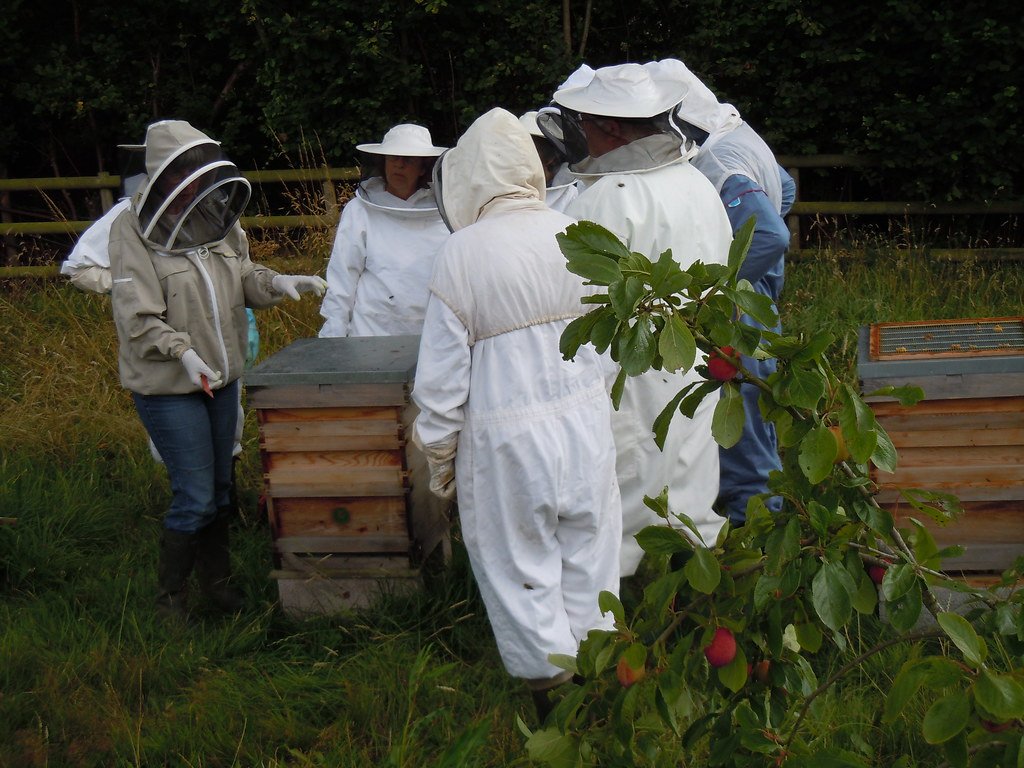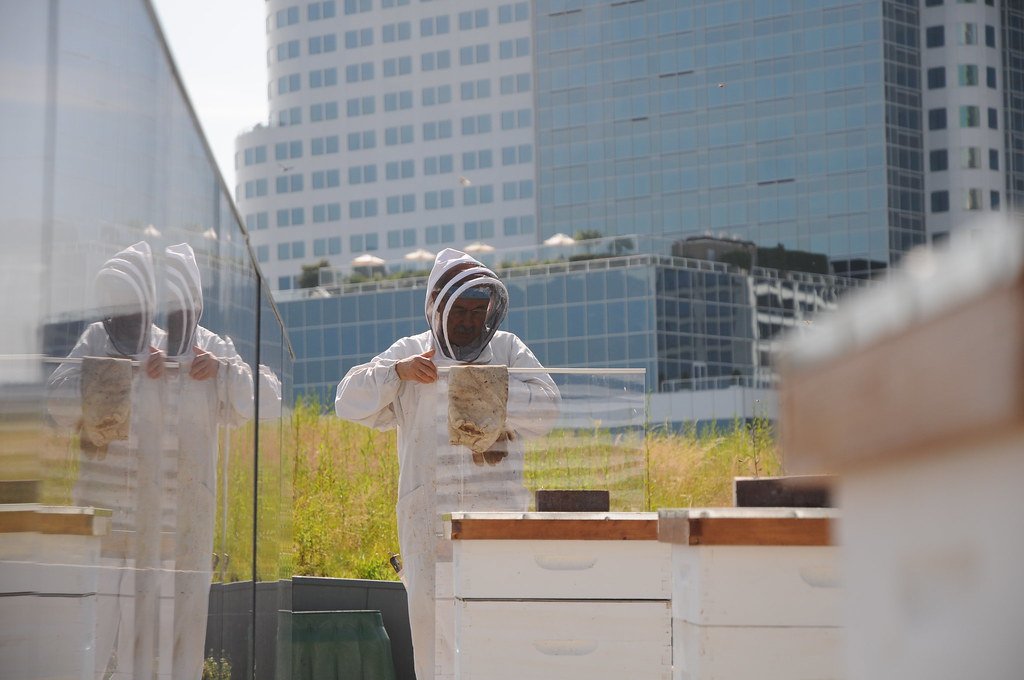As bustling cities continue to evolve, buzzing with life and energy, a curious trend has emerged amidst the concrete forests and towering skyscrapers: urban beekeeping. Gone are the days when apiaries were solely confined to rural landscapes; today, rooftop hives and backyard honeybees are taking center stage in urban communities around the world. However, this newfound harmony between humans and their tiny pollinating partners has not come without its fair share of controversy. The impact of local ordinances on urban beekeeping remains a hot topic of debate, as city officials grapple with striking a delicate balance between fostering sustainable agriculture and addressing the concerns of a diverse urban populace. In this article, we will delve into the constraints and challenges faced by urban beekeepers, exploring the intricate tapestry of local regulations and their profound effects on this buzzing urban subculture. So, let us embark on a journey into the fascinating world of urban beekeeping, where bees and bureaucracy meet head-on in the quest for coexistence amidst the cityscape.
Table of Contents
- Understanding Local Ordinances: A Key to Harmonizing Urban Beekeeping
- Exploring the Positive Impacts of Urban Beekeeping in Local Communities
- Navigating Potential Challenges: The Impact of Local Ordinances on Urban Beekeeping
- Promoting Sustainable Urban Beekeeping Practices through Collaborative Regulations
- Strategies for Optimizing Urban Beekeeping Harmony: Recommendations for Local Ordinances
- Q&A
- Future Outlook

Understanding Local Ordinances: A Key to Harmonizing Urban Beekeeping
Why Understanding Local Ordinances is Vital for Urban Beekeeping
As the interest in urban beekeeping continues to thrive, it becomes increasingly important for aspiring beekeepers to familiarize themselves with local ordinances. These regulations may vary widely from one city to another, or even within different neighborhoods of the same city. By knowing and adhering to these local laws, beekeepers can ensure the harmonious coexistence of honey bees and city dwellers.
Some common aspects covered by local ordinances include:
- Permitting requirements: Many cities require beekeepers to obtain permits or licenses to keep bees within city limits. These permits may involve fees, inspections, or specific qualifications such as attending beekeeping classes.
- Hive placement restrictions: Ordinances may dictate where bee hives can be located, such as minimum distances from property lines, neighbors’ homes, or public areas. These guidelines aim to minimize disturbances and potential conflicts.
- Hive quantity limitations: To prevent overcrowding or potential risks to the surrounding areas, some cities may restrict the number of hives a beekeeper can maintain.
By understanding and following local ordinances, urban beekeepers can not only promote the health and conservation of honey bees but also foster positive relationships with their communities.

Exploring the Positive Impacts of Urban Beekeeping in Local Communities
Urban beekeeping has emerged as a trend that not only benefits the bees themselves but also has numerous positive impacts on local communities. Here are some key reasons why this practice is gaining popularity:
- Promoting pollination: Bees are essential for pollinating flowers, trees, and crops. By keeping beehives in urban areas, we can ensure a steady supply of bees to pollinate the local flora, leading to increased biodiversity and healthier ecosystems.
- Environmental conservation: Urban beekeeping encourages the preservation of green spaces within cities. To support beehives, communities often create urban gardens or plant bee-friendly flowers, helping to combat urbanization’s negative effects on the environment.
- Education and awareness: Beekeeping in local communities provides an opportunity for education and raising awareness about the importance of bees and their role in our ecosystem. This can be achieved through workshops, hive visits, and public talks.
The positive impacts of urban beekeeping extend beyond the bees themselves. It enhances the overall well-being of communities, fostering a connection to nature and promoting sustainable living practices. As more people embrace urban beekeeping, we can look forward to flourishing ecosystems and a stronger sense of environmental stewardship.

Navigating Potential Challenges: The Impact of Local Ordinances on Urban Beekeeping
Urban beekeeping has experienced a surge in popularity in recent years, with environmentally conscious individuals and communities embracing the practice as a means of promoting biodiversity and tackling the decline of honeybee populations. However, this burgeoning interest has come with its fair share of challenges, particularly when it comes to navigating local ordinances and regulations.
One of the key issues faced by urban beekeepers is the lack of standardized regulations across different municipalities. As a result, beekeepers often find themselves wading through a labyrinth of varying rules and restrictions, making it essential to thoroughly research and understand the local ordinances specific to their area. It is imperative to assess factors such as permissible hive locations, setback requirements, and limits on the number of hives allowed per property.
Furthermore, obtaining necessary permits is an important step in complying with local ordinances. Understanding the application process and any associated fees or documentation required is paramount. Seeking support from local beekeeping associations or attending community meetings can provide valuable insights and guidance in navigating these bureaucratic hurdles.

Promoting Sustainable Urban Beekeeping Practices through Collaborative Regulations
Urban beekeeping is on the rise as people become more aware of the critical role that bees play in our ecosystem. However, without proper regulations, it is essential to promote sustainable practices to ensure the well-being of both the bees and the urban environment. Collaborative regulations provide a unique opportunity to find a balance between protecting the interests of beekeepers and addressing concerns of urban residents.
One key aspect of promoting sustainable urban beekeeping practices is the establishment of guidelines for hive placement. By collaborating with urban planners and local communities, regulations can be developed that take into account the needs of both the bees and the surrounding environment. This could include creating designated beekeeping zones that are far away from densely populated areas, ensuring that the bees have access to abundant sources of nectar and reducing potential conflicts with residents.
Another crucial factor in sustainable urban beekeeping is educating beekeepers about responsible hive management. Collaborative regulations can require mandatory training and certification programs, ensuring that beekeepers possess the necessary knowledge and skills to care for their hives properly. This could include topics such as hive health maintenance, pest management strategies, and sustainable beekeeping practices that prioritize the well-being of the bees.
- Promote sustainable urban beekeeping practices
- Create guidelines for hive placement
- Collaborate with urban planners and communities
- Establish designated beekeeping zones
- Ensure abundant sources of nectar for bees
- Require mandatory training and certification programs
- Educate beekeepers about responsible hive management
- Focus on hive health maintenance and pest management
- Prioritize the well-being of the bees
With collaborative regulations that address these issues, urban beekeeping can thrive while maintaining a balance with the urban environment. By promoting sustainable practices and educating beekeepers, we can create a harmonious coexistence between bees, beekeepers, and urban residents, ensuring the long-term survival and health of these essential pollinators.
Strategies for Optimizing Urban Beekeeping Harmony: Recommendations for Local Ordinances
Creating an environment that fosters harmonious coexistence between urban beekeepers and city dwellers is crucial for the success of urban beekeeping initiatives. By enacting appropriate local ordinances, cities can both support bee populations and ensure the well-being of their residents. Here are some recommended strategies for optimizing urban beekeeping harmony:
- Collaborative Planning: Involve urban beekeepers, local government officials, and community members in the planning process to establish clear guidelines and ensure the best interest of all stakeholders is met.
- Education and Awareness: Implement educational programs and awareness campaigns to help citizens understand the importance of bees in urban ecosystems, dispel misconceptions, and encourage community support for urban beekeeping.
- Siting and Distance Requirements: Specify appropriate locations for urban beehives, keeping in mind the safety and comfort of nearby residences. Establish minimum distance requirements to address concerns related to potential stinging incidents.
- Noise and Odor Control: Consider regulations to address noise and odor concerns associated with urban beekeeping, ensuring that neighbors’ quality of life is not negatively impacted while allowing bees to thrive.
- Hive Management Standards: Establish guidelines for hive maintenance, including regular inspections, disease control measures, and responsible management practices to minimize potential risks and maintain healthy bee colonies.
By implementing these proactive strategies in local ordinances, urban areas can strike a balance that supports bee populations, preserves the urban landscape, and allows residents to embrace the benefits of urban beekeeping. Together, we can create a sustainable and harmonious environment for both bees and urban communities.
Q&A
Q: How do local ordinances affect urban beekeeping?
A: Local ordinances can have a significant impact on urban beekeeping. They dictate where hives can be placed, how many hives are allowed, and whether beekeepers need permits. Some ordinances also set guidelines for beekeeping practices to protect public safety and preserve the urban environment.
Q: What are some common restrictions in local ordinances?
A: Local ordinances often restrict the number of hives per property, specify setback distances from neighboring buildings, and sometimes require that hives be located behind barriers. These restrictions aim to alleviate potential concerns such as bee stings, hive interference, and nuisance complaints.
Q: Are there any benefits to local ordinances for urban beekeepers?
A: Yes, local ordinances can provide several benefits for urban beekeepers. They can protect the bees from harmful substances, ensure proper hive management practices, and establish guidelines for responsible beekeeping. These regulations also foster positive community relationships by addressing concerns and promoting education about the benefits of bees.
Q: How do ordinances balance the interests of beekeepers and residents?
A: Ordinances often strike a balance between the interests of beekeepers and residents by imposing limitations to address potential conflicts. These restrictions aim to minimize the risk of bee-related incidents while still allowing urban beekeeping enthusiasts to enjoy their hobby and contribute to local ecosystems.
Q: How can urban beekeepers influence local ordinances?
A: Urban beekeepers can influence local ordinances by actively engaging with their city council and local government officials. They can educate officials about the benefits of bees, offer to participate in public outreach programs, and share success stories of responsible urban beekeeping. By collaborating and demonstrating their commitment, urban beekeepers can help shape beekeeping regulations in their communities.
Q: Is urban beekeeping worthwhile despite the impact of local ordinances?
A: Absolutely! Urban beekeeping remains a meaningful and rewarding practice. Although local ordinances pose certain restrictions, they also provide a framework for responsible beekeeping. By adhering to these regulations, urban beekeepers can make a positive impact on their communities while enjoying the numerous benefits of keeping bees.
Future Outlook
As the buzzing symphony of our urban landscapes continues to evolve, the impact of local ordinances on urban beekeeping has become a topic of immense intrigue. The intricate dance between humans and honeybees, once restricted to rural landscapes, has now seeped into the concrete jungles we call home. In this exploration, we have delved into the delicate balance between fostering a harmonious relationship with these industrious insects and addressing the concerns and interests of our urban communities.
Throughout this article, we have witnessed the profound influence that local ordinances wield over the fate of urban beekeeping. These rulings, akin to whimsical choreographers, guide the steps taken within the realm of apiculture, shaping the vibrant tapestry of urban beekeeping. They act as a framework, gently nudging us towards responsible practices, while transmuting the dreams and aspirations of budding urban beekeepers into reality.
While we aim to advocate for conservation and honeybee triumphs in our bustling cities, it is crucial to acknowledge the multifaceted nature of the situation. Urban beekeeping, with its inherent challenges and concerns, necessitates careful regulations that cater to the nuances and needs of each unique metropolis. It is in this dance between control and freedom that we find the delicate stance held by local ordinances.
Yet, let us not disregard the immeasurable value that urban beekeeping bestows upon society. Beyond the honey jars and beeswax candles, these humble bee colonies empower us to reconnect with nature amidst the concrete confines. They paint vibrant strokes of biodiversity onto the urban canvas, enriching our urban landscapes with splashes of vibrant colors and fragrant blooms. Through their tireless pollination, they lend a helping hand to our dwindling plant populations, reminding us of the intricate interdependence that binds all living beings.
As we conclude this exploration into the impact of local ordinances on urban beekeeping, it is clear that the preservation and cultivation of this ancient craft rests in the hands of both city dwellers and policymakers. Together, we must seek a delicate balance between nurturing our cities’ ecosystems and addressing the valid concerns raised by our communities. With collaborative efforts and open-minded discussions, we can create ordinances that not only safeguard the interests of our urban landscapes but also allow the enchanting world of beekeeping to flourish in even the most unlikely of places.
In this story of cities and hives, let us continue to dance, finding harmony between progress and preservation. Only then can we truly appreciate the indomitable spirit of these humble creatures and understand the profound impact their presence holds on the urban tapestry we call home.
As an affiliate, my content may feature links to products I personally use and recommend. By taking action, like subscribing or making a purchase, you’ll be supporting my work and fueling my taco cravings at the same time. Win-win, right?
Want to read more? Check out our Affiliate Disclosure page.